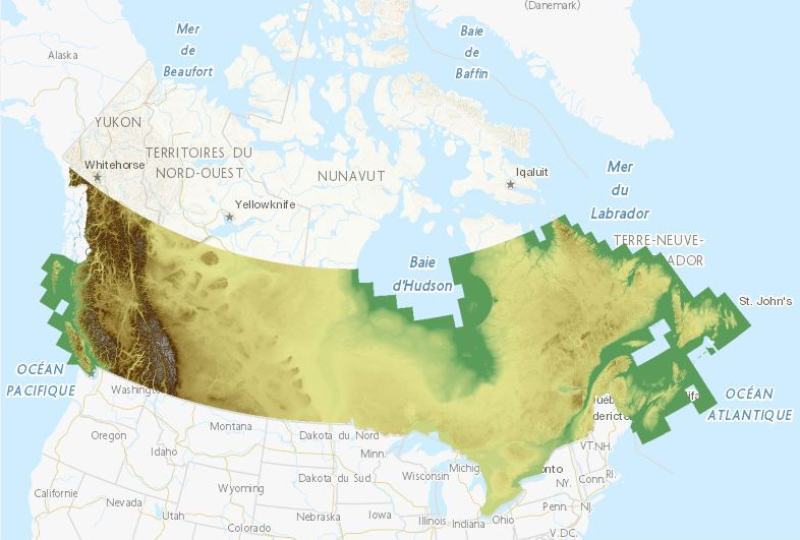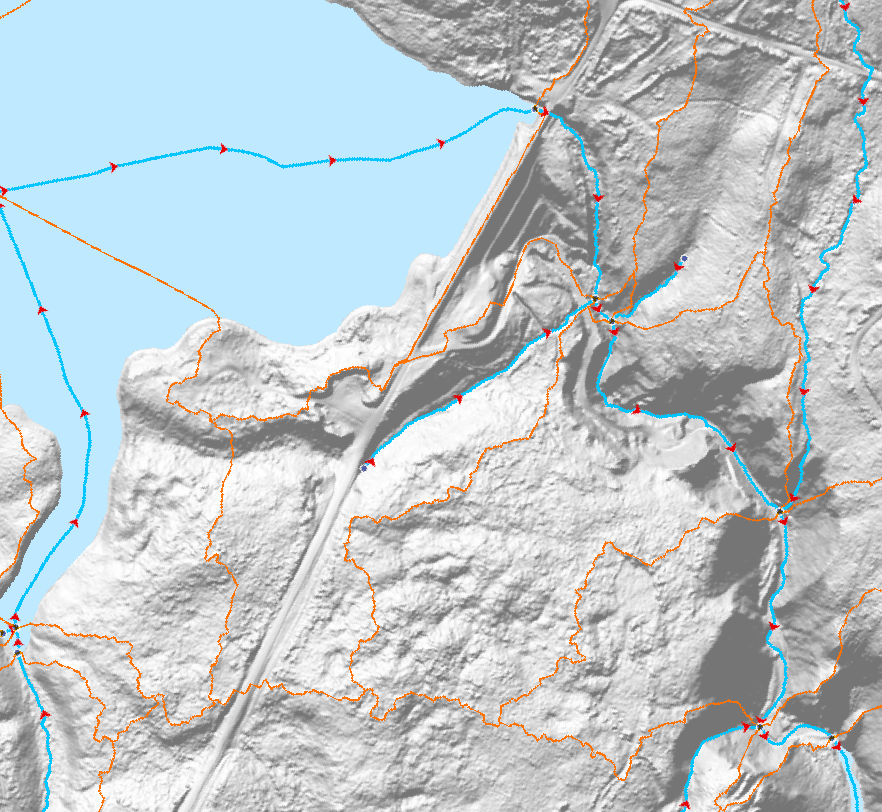GeoBase
Type of resources
Available actions
Topics
Keywords
Contact for the resource
Provided by
Formats
Representation types
Update frequencies
status
-

The National Rail Network (NRWN) is a geometric and attributive description of the Canadian rail network. The NRWN product consists of the features classes: Track Segment, Railway Crossing, Railway Station, Marker Post, Junction and Railway Structure. Descriptive attributes include amongst others: Track Classification, Track Name, Track Operator, Track User, Track Owner, Subdivision Name, Junction Type, Crossing Type, Level of Crossing, Warning System, Transport Canada Identifier, Station Name, Station Type, Station User, Structure Type.
-

This collection is a legacy product that is no longer supported. It may not meet current government standards. This inventory presents chronologically the satellite images acquired, orthorectified and published over time by Natural Resources Canada. It is composed of imagery from the Landsat7 (1999-2003) and RADARSAT-1 (2001-2002) satellites, as well as the CanImage by-product and the control points used to process the images. Landsat7 Orthorectified Imagery: The orthoimage dataset is a complete set of cloud-free (less than 10%) orthoimages covering the Canadian landmass and created with the most accurate control data available at the time of creation. RADARSAT-1 Orthorectified Imagery: The 5 RADARSAT-1 images (processed and distributed by RADARSAT International (RSI) complete the landsat 7 orthoimagery coverage. They are stored as raster data produced from SAR Standard 7 (S7) beam mode with a pixel size of 15 m. They have been produced in accordance with NAD83 (North American Datum of 1983) using the Universal Transverse Mercator (UTM) projection. RADARSAT-1 orthoimagery were produced with the 1:250 000 Canadian Digital Elevation Data (CDED) and photogrammetric control points generated from the Aerial Survey Data Base (ASDB). CanImage -Landsat7 Orthoimages of Canada,1:50 000: CanImage is a raster image containing information from Landsat7 orthoimages that have been resampled and based on the National Topographic System (NTS) at the 1:50 000 scale in the UTM projection. The product is distributed in datasets in GeoTIFF format. The resolution of this product is 15 metres. Landsat7 Imagery Control Points: the control points were used for the geometric correction of Landsat7 satellite imagery. They can also be used to correct vector data and for simultaneously displaying data from several sources prepared at different scales or resolutions.
-
GeoAI are buildings, hydrography, forests, and roads automatically extracted using Deep Learning models applied to a source dataset, typically aerial or satellite images. The primary aim of GeoAI is to increase Canada's availability of high-resolution foundational geospatial data for both spatial and temporal coverage. The infrastructure and expertise put in place by NRCan enables a rapid, efficient, and scalable data creation process through the use of leading-edge technology and Artificial Intelligence models. Published datasets for a given source can be revisited at a later date as more accurate models are developed and put into production. For now, only static files are available, but as the series develops, new products and services will be added.
-

This is a legacy product that is no longer supported. It may not meet current government standards. The Canadian Digital Surface Model (CDSM) is part of Natural Resources Canada's altimetry system designed to better meet the users' needs for elevation data and products. The 0.75-second (~20 m) CDSM consists of a derived product from the original 1-second (30 m) Shuttle Radar Topographic Mission (SRTM) digital surface model (DSM). In these data, the elevations are captured at the top of buildings, trees, structures, and other objects rather than at ground level. A CDSM mosaic can be obtained for a pre-defined or user-defined extent. The coverage and resolution of a mosaic varies according to the extent of the requested area. Derived products such as slope, shaded relief and colour shaded relief maps can also be generated on demand by using the Geospatial-Data Extraction tool. Data can then be saved in many formats. The pre-packaged GeoTiff datasets are based on the National Topographic System of Canada (NTS) at the 1:50 000 scale; the NTS index file is available in the Resources section in many formats.
-

This collection is a legacy product that is no longer supported. It may not meet current government standards. The Canadian Digital Elevation Model (CDEM) is part of Natural Resources Canada's altimetry system designed to better meet the users' needs for elevation data and products. The CDEM stems from the existing Canadian Digital Elevation Data (CDED). In these data, elevations can be either ground or reflective surface elevations. A CDEM mosaic can be obtained for a pre-defined or user-defined extent. The coverage and resolution of a mosaic varies according to latitude and to the extent of the requested area. Derived products such as slope, shaded relief and colour shaded relief maps can also be generated on demand by using the Geospatial-Data Extraction tool. Data can then be saved in many formats. The pre-packaged GeoTiff datasets are based on the National Topographic System of Canada (NTS) at the 1:250 000 scale; the NTS index file is available in the Resources section in many formats.
-

This collection is a legacy product that is no longer supported. It may not meet current government standards. Canada's Orthoimages 2005-2010 is the national medium-resolution imagery coverage of Canada. These digital raster data acquired by the Spot4 and Spot5 satellites comprise five spectral bands, namely: a panchromatic band having 10 m pixels and four multispectral bands having pixels of 20 m. These orthoimages were produced according to the 1983 North American Reference System (NAD83SCRS) according to the Universal Transverse Mercator (UTM) and Lambert Conformal Conic (LCC) mapping. The set of orthoimages was created with the most accurate control data available at the time of its creation: Landsat7 Imagery Control Points, National Road Network (NRN) ) and the Landsat7 Orthorectified Imagery.
-

This collection is a legacy product that is no longer supported. It may not meet current government standards. Land Cover information is the result of vectorization of raster thematic data originating from classified Landsat 5 and Landsat 7 ortho-images, for agricultural and forest areas of Canada, and for Northern Territories. The forest cover was produced by the Earth Observation for Sustainable Development (EOSD) project, an initiative of the Canadian Forest Service (CFS) with the collaboration of the Canadian Space Agency (CSA) and in partnership with the provincial and territorial governments. The agricultural coverage is produced by the National Land and Water Information Service (NLWIS) of Agriculture and Agri-Food Canada (AAFC). Northern Territories land cover was realized by the Canadian Centre of Remote Sensing (CCRS). Land Cover data are classified according to a harmonized legend build from the partner's legends. This legend is principally based on the legend described in following publication: EOSD publication: EOSD Land Cover Classification Legend Report, on which CFS and AAFC collaborated. Some classes related to Northern environments where added in order to meet the interpretation of the Northern land cover classification experts. Initially, Land Cover vector data are closest as possible to the source (original raster data). Slight differences can occur because the raster data goes through a data portrayal before being vectorized in order to enhance visual representation such as minimum size, smoothness of polygons and geometry.
-

The Canadian Hydrospatial Network (CHN) is an analysis-ready geospatial network of features that help enable the modelling of surface water flow in Canada. The six main layers and feature types are: flowlines, waterbodies, catchments, catchment aggregates, work units, and hydro nodes. Where possible the CHN is derived from high resolution source data such as Light Detection and Ranging (LiDAR) derived Digital Elevation Models (DEMs) and aerial imagery, to name a few. If existing provincial or territorial hydrographic networks meet the standards, they are incorporated into the CHN, otherwise automatic extraction methods are used on the high-resolution source data. To provide full network connectivity, if neither of these methods is possible in a region, the NHN is converted into the CHN until higher-resolution source data is available. Additional value-added attributes are included in the CHN to aid modelling, such as stream order and reach slope. The CHN physical model and features are also closely aligned and harmonized with the USGS 3DHP hydrographic network, which aids trans-border modelling. Where possible geonames (i.e. toponyms) are also added. The CHN is produced and disseminated by hydrologically connected geographic areas called work units. Work units can contain just one watershed, several small adjacent watersheds outletting into a large body of water, or be one of many parts of a larger watershed. In all cases, the features of a work unit are hydrologically connected. This is a more natural approach to data delivery, in comparison to data that is split into tiles. A generalized work unit index file is provided in the downloads to help users decide which files to download. For more information on the CHN please visit the project webpage: https://natural-resources.canada.ca/canadian-hydrospatial-network
-
The National Hydro Network (NHN) focuses on providing a quality geometric description and a set of basic attributes describing Canada's inland surface waters. It provides geospatial digital data compliant with the NHN Standard such as lakes, reservoirs, watercourses (rivers and streams), canals, islands, drainage linear network, toponyms or geographical names, constructions and obstacles related to surface waters, etc. The best available federal and provincial data are used for its production, which is done jointly by the federal and interested provincial and territorial partners. The NHN is created from existing data at the 1:50 000 scale or better. The NHN data have a great potential for analysis, cartographic representation and display and will serve as base data in many applications. The NHN Work Unit Limits were created based on Water Survey of Canada Sub-Sub-Drainage Area.
 Arctic SDI catalogue
Arctic SDI catalogue